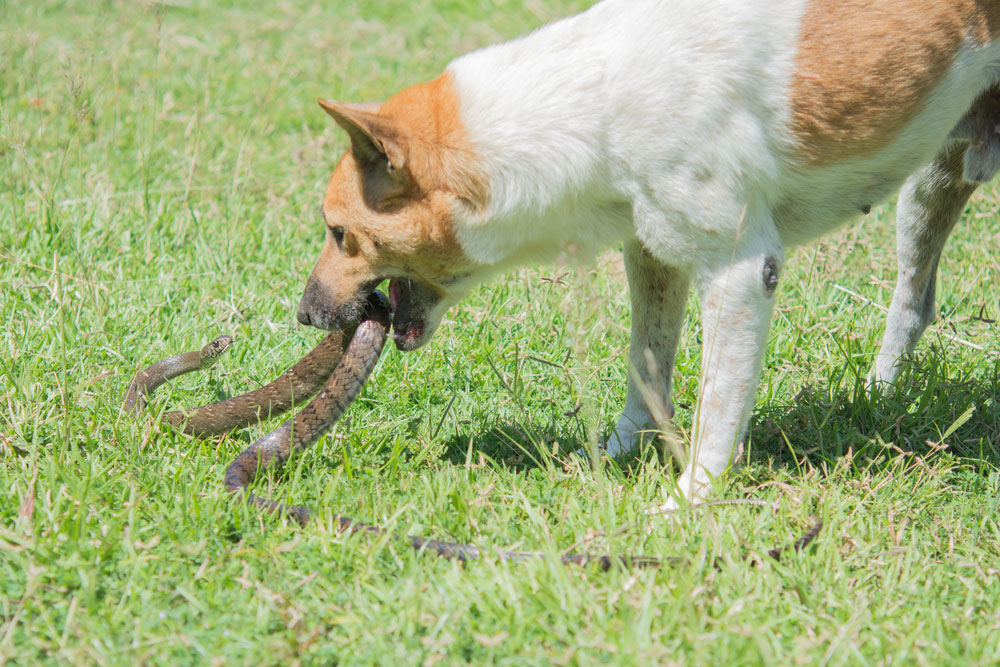In northern Arizona, rattlesnakes are part of everyday life—from hiking trails to backyards. While these snakes play an important role in the ecosystem, they also pose a serious medical risk to pets. At VESCONA, we see firsthand how quickly a rattlesnake bite can turn into a life-threatening emergency.
This guide is here to help you recognize the signs, respond appropriately, and take steps to reduce your pet’s risk—because with snakebites, what you do in the first hour matters most.
How Rattlesnake Bites Affect Pets
When a rattlesnake bites, it may inject venom containing enzymes and toxins that cause:
- Severe tissue damage
- Disruption of blood clotting
- Circulatory collapse
- Organ dysfunction
Even a small amount of venom can trigger rapid swelling, intense pain, and systemic effects in minutes. Larger dogs may tolerate venom longer than small pets—but all bites should be treated as emergencies.
Important note: A smaller snake does not mean a safer bite. In fact, younger rattlesnakes may deliver more venom because they haven’t learned to regulate how much they inject. The result can be especially dangerous for pets of any size.
Seasonal activity: Rattlesnakes are most active from spring through early fall, especially at dawn and dusk. In Flagstaff’s high-desert environment, they’re commonly found in brushy areas, rocky trails, woodpiles, and under porches.
Learn more about Arizona’s snake species →
Symptoms of Envenomation: What to Look For
If your pet is bitten, symptoms may appear immediately or develop within hours:
- Sudden swelling at the bite site (commonly face or legs)
- Severe pain or vocalization
- Bleeding or bruising from fang punctures
- Rapid breathing or panting
- Lethargy or collapse
- Drooling, vomiting, or trembling
Even if the bite site looks small, internal damage may already be progressing. Do not wait to see if symptoms improve—venom toxicity can escalate rapidly.
More on treating snake bites in pets – ASPCApro
How We Diagnose and Treat Snakebites
At VESCONA, our team is equipped to provide immediate, specialized care:
Initial Stabilization
- IV fluids to support blood pressure and prevent shock
- Pain control with fast-acting medications
- Monitoring of vital signs and swelling progression
Laboratory Diagnostics
- Coagulation testing to check for venom-induced clotting disorders
- Blood chemistry panels to assess kidney, liver, and muscle damage
- Urinalysis to screen for systemic impact
Antivenin Administration
- Antivenin helps neutralize venom and slow tissue destruction.
- It’s most effective when given early and may reduce total recovery time, complications, and mortality risk.
Supportive Measures
- Wound management if tissue necrosis occurs
- Antibiotics to prevent secondary infection
- Oxygen therapy or blood transfusions in severe cases
We handle snake bites—and all other bites—at VESCONA
What Happens If a Snakebite Goes Untreated
Untreated envenomation can lead to:
- Severe swelling and tissue necrosis
- Irreversible organ damage
- Infection and sepsis
- Chronic pain, permanent disfigurement, or death
Even pets that survive may face long-term complications such as limb dysfunction or behavioral changes due to pain or trauma.
Snake bites and pets – Texas A&M Pet Talk
Aftercare: What Recovery Looks Like
Recovery time depends on how much venom was injected and how quickly treatment was started. Most pets need:
- Ongoing wound care
- Pain management
- Restricted activity to allow healing
- Follow-up bloodwork to monitor for delayed effects
We’ll walk you through every step of your pet’s care plan and provide tailored instructions for at-home support.
Preventing Snake Encounters
You can’t eliminate all risk, but smart prevention goes a long way:
- Leash your dog on hikes and avoid letting them roam off trail.
- Install snake fencing in your yard and clear brush or debris where snakes may hide.
- Avoid hiking at dusk or dawn, when snakes are most active.
- Hike primarily in cooler weather. Learn more from Arizona Game & Fish: Rattlesnakes become more active as weather warms
- Enroll in snake avoidance training with a certified professional.
- Ask your vet about the rattlesnake vaccine, which may reduce severity but is not a substitute for emergency care.
Learn more from ASU: How to avoid getting bitten by a rattlesnake
What to Do If Your Pet Is Bitten
- Stay calm and keep your pet as still as possible.
- Do not try to suck out venom, cut the wound, or apply ice or tourniquets.
- Call us immediately at 928-962-4399 and transport your pet to the nearest emergency vet.
- If possible, take a photo of the snake from a safe distance—but never try to catch or kill it.
More on rattlesnake envenomation – Embrace Pet Insurance

FAQs
How soon should I bring my pet in after a snakebite?
Immediately. Even if symptoms are mild, early treatment improves outcomes dramatically.
Is antivenin always used?
Not always, but it’s recommended in most envenomation cases. We evaluate based on bite severity, patient size, and time elapsed.
Can cats be affected too?
Yes. Though less likely to be bitten than dogs, cats often suffer more severe tissue damage due to smaller body size and delayed presentation.
When Every Minute Counts, We’re Here
Rattlesnake bites are frightening—but they are survivable with the right care at the right time. At VESCONA, our experienced team is trained to handle high-stakes emergencies with urgency, skill, and compassion.
Call us 24/7 at 928-962-4399
Meet our emergency care team







Leave A Comment